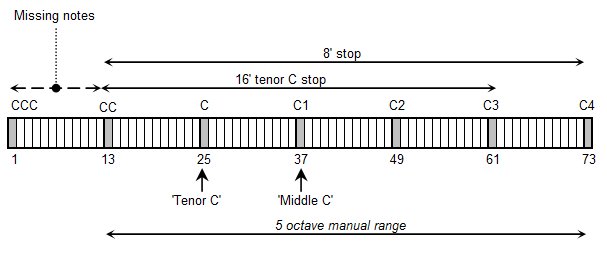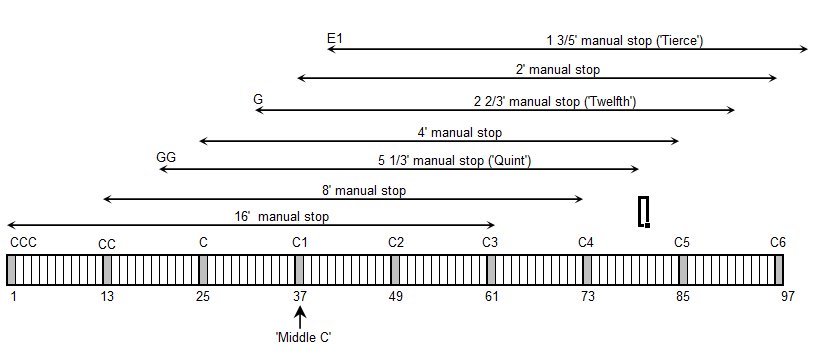The word Pitch is used in many musical contexts, but fundamentally it refers to the frequency of a note – a low-sounding note being said to have a ‘low’ pitch and a high-sounding note to have a ‘high’ pitch.
Pitch is also used more specifically to denote different categories of stop, for example 16 foot, 8 foot, 4 foot etc. (usually denoted 16′, 8′, 4′ etc).
If middle C is played and an 8′ stop is drawn, then the pipe that plays will also be middle C. If middle C is played and a 4′ stop is drawn, then the pipe that plays will be an octave higher than middle C, and if a 16′ stop is drawn then the pipe an octave lower will play. Thus if a single note is played and 16′, 8′ and 4′ stops are drawn then three separate pipes will play, one an octave lower, one in unison and one an octave higher than the note played.
Stops may also be pitched at intervals other than an octave, in which case they are generically termed ‘mutation’ stops.
Analysis of sounds produced by any vibrating body or mass (such as the air in an organ pipe) shows that, apart from the fundamental pitch of the note produced, a series of lesser notes of different (mainly higher) pitch are also produced which provide colour to the note itself. These lesser notes are termed harmonics and are at defined intervals above the fundamental pitch of the note. Some of these intervals are whole octaves above the fundamental, and others part octaves. By introducing mutations stops at these part octave intervals, the harmonic structure of the organ chorus is reinforced. Figure 2 shows the mutation stops most commonly encountered on the theatre organ, and their relation to the unison.
The nomenclature for the different pitches of organ stops is derived from the speaking length of open flue pipes speaking at CC. An 8′ Open Diapason pipe playing CC will be 8′ long, a 4′ pipe will be 4′ long and so on. Stopped flue pipes sound an octave lower than open pipes of the same speaking length, so an 8′ Tibia Clausa (stopped) pipe will be 4′ long.
Pitch is also used to describe the way an organ is tuned; most modern instruments are tuned to A = 440 beats per second (Hertz), sometimes known as Concert Pitch; organs built in the earlier part of the 20th Century and before may have been tuned to a lower pitch, such as A = 435 Hertz, and it is not unknown to find instruments which have had their pitch raised subsequently to A = 440 Hertz.
